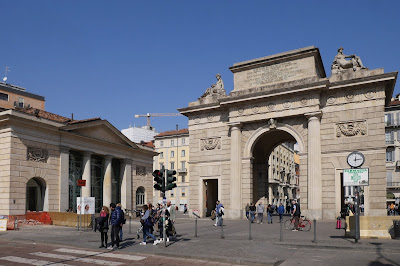Via Malpeghi, 3: Milan's finest art nouveau building
I found this walk around one of Milan's art nouveau areas on the website of Michele Sacerdoti. I am deeply in his debt. This section of his website lists three walks, but we only had time to do the first. The only flaw was that there are no pictures of the buildings, but this really did make it a voyage of discovery. The text is doubtless very informative, but my Italian is not up to profiting from it; I could at least spot the architects and dates of the buildings that caught my eye.
We started at Piazza Oberdan, north east of the Duomo, and after a brief struggle to orientate ourselves, reached the real start of the walk at Viale Piave. The first building we saw, at number 42, wasn't too impressive: heavy flower motifs, but not much else, so we headed on to Via de Bernardi 1, on the corner with Viale Piave (1905 by G B Bossi).
There were interesting motifs on the facade and a lovely three-storey window. presumably lighting the main staircase.
We ignored the next building also by Bossi as being inelegant, and turned right into via Goldoni and left in via Pisacane, where things really looked up.
We loved the fluid mouldings over the windows and front door and the band of colour across the top floor windows of number 12 (by A Campani, 1903). The iron work on the balconies was classic art nouveau.
At number 16 (by A Fermani 1902) we were struck by the front door and ironwork, but again the floral plasterwork seemed heavy and overdone.
We passed by number 20 and 24 (rather the worse for wear) and turned into via Modena, to reach the junction with via Menotti. The contrast between the rather battered house on the right with the totally renovated (including removing the exterior rendering) house on the left was startling. They seemed to share the variant of art nouveau that we saw in Riga, Latvia.
Further along via Menotti, at number 1, was this building with lovely floral panels, at their best at the sides where there were balconies.
From here on we became more selective, highlighting only the best buildings. The next of which was on the corner of via Moderna and via Uberti. The most obvious feature was the blue squares, but a closer view revealed lovely flower patterns to offset them.
Next door, at via Modena 28, Casa Maggioni (1909), was another beautiful specimen. Lovely front door, iron work, windows on the top floor and yellow, almost golden, ceramic tiles.
We passed a few other less inspiring buildings to reach the triumphant conclusion of the walk, Via Malpeghi, 3 which was close to the start/end point of the walk at Piazza Oberdan. This is a fantastic building of 1905 covered with ceramic panels. The three picture below show the left side, and the two sections of the right side (it is on a corner - see the picture at the head of this post).
Conditions: hot and sunny.
Disatnce: probably only a couple of miles.
Rating: four and half stars. Some absolute gems, although quite a few fairly crude examples too.

























































